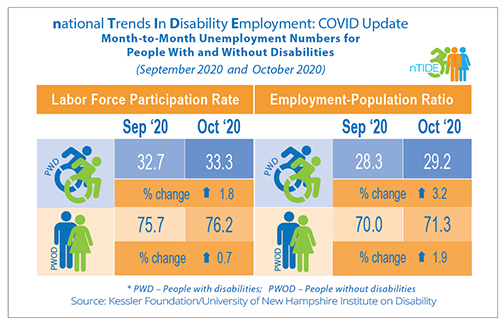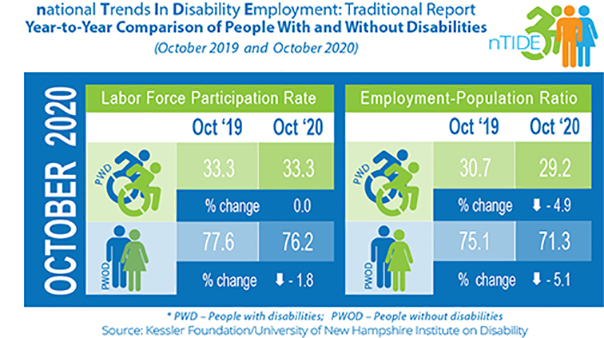nTIDE October 2020 Jobs Report: Job numbers hold steady for Americans with disabilities
East Hanover, NJ - November 6, 2020 - October's job numbers showed small changes for Americans with and without disabilities, according to today's National Trends in Disability Employment - Monthly Update (nTIDE), issued by Kessler Foundation and the University of New Hampshire's Institute on Disability (UNH-IOD). Although people with disabilities have remained engaged in the labor market, the ongoing effects of the pandemic and uncertainty about continued federal aid are major concerns as the year draws to a close.
nTIDE COVID Update (month-to-month comparison)

In the Bureau of Labor Statistics (BLS) Jobs Report released Friday, the employment-to-population ratio for working-age people with disabilities increased from 28.3 percent in September to 29.2 percent in October 2020 (up 3.2 percent or 0.9 percentage points). For working-age people without disabilities, the employment-to-population ratio also increased from 70.0 percent in September to 71.3 percent in October 2020 (up 1.9 percent or 1.3 percentage points). The employment-to-population ratio, a key indicator, reflects the percentage of people who are working relative to the total population (the number of people working divided by the number of people in the total population multiplied by 100).
"While October's gains were modest for people with and without disabilities, this is encouraging in light of the continued effects of COVID-19," said John O'Neill, PhD, director of employment and disability research at Kessler Foundation. He added, "However, we may see declines in the employment-to-population ratio next month as COVID-19 infections increase during the fall and federal aid has yet to be renewed."
The labor force participation rate for working-age people with disabilities increased from 32.7 percent in September to 33.3 percent in October 2020 (up 1.8 percent or 0.6 percentage points). For working-age people without disabilities, the labor force participation rate also increased from 75.7 percent in September to 76.2 percent in October 2020 (up 0.7 percent or 0.5 percentage points). The labor force participation rate is the percentage of the population that is working, not working and on temporary layoff, or not working and actively looking for work.
"The labor force participation rate improved slightly compared to last month reaching the same level compared to this time last year," noted economist Andrew Houtenville, PhD, research director of the University of New Hampshire's Institute on Disability. "This is good news and suggests people with disabilities are staying engaged in the workforce by either working, actively looking for work, or expecting to be recalled. It will be important to track this indicator as economic restrictions are reinstated to combat the increasing spread of COVID-19."
nTIDE COVID Update - Friday, November 20 at 12:00 pm Eastern
Stay tuned for more about the employment of people with disabilities as we follow the impact of COVID-19 and look at the numbers in more detail.
Traditional nTIDE Numbers (comparison to the same time last year)

The employment-to-population ratio for working-age people with disabilities decreased from 30.7 percent in October 2019 to 29.2 percent in October 2020 (down 4.9 percent or 1.5 percentage points). For working-age people without disabilities, the employment-to-population ratio also decreased from 75.1 percent in October 2019 to 71.3 percent in October 2020 (down 5.1 percent or 3.8 percentage points).
The labor force participation rate for working-age people with disabilities was the same, 33.3 percent in October 2019 to 33.3 percent in October 2020 (up 0 percent or 0 percentage points). For working-age people without disabilities, the labor force participation rate decreased from 77.6 percent in October 2019 to 76.2 percent in October 2020 (down 1.8 percent or 1.4 percentage points).
In October 2020, among workers ages 16-64, the 4,344,000 workers with disabilities represented 3.1 percent of the total 140,340,000 workers in the U.S.
Funding for nTIDE is provided by Kessler Foundation.
Beyond the Numbers
As job losses steepen and more Americans begin actively looking for work, the landscape is changing for jobseekers with disabilities and the agencies that support their competitive integrated employment. For more than 40 years, Job Path, a not-for-profit provider agency in New York City has provided employment and day and residential support services for people with autism and other developmental disabilities, aiming for inclusion in community life, as well as the workplace.
While employment is the major focus, Job Path fosters involvement in community life, encouraging clients to volunteer with organizations that interest them, and engage in hobbies, artistic and spiritual pursuits. Job Path blends and braids multiple sources of funding to create comprehensive opportunities for individuals with developmental disabilities to work, live and play in their communities of choice. To accomplish this Job Path draws on multiple funding sources including state vocational rehabilitation, foundation funding, government grants, Medicaid's waiver funding, Social Security's Ticket to Work program, and local funding.
In New York City, more than 100 employers have hired workers with disabilities through Job Path, for jobs in diverse areas including retail, animal care, childcare, healthcare, clerical and administration, food service, media and communications, and maintenance services. Using customized employment strategies, Job Path works with each individual to identify their skills and talents and works with employers to create positions that meet the needs of both the business and the job seekers. Job Path's job coaches provide flexible ongoing support for new hires, maximizing their likelihood of success. With this approach, Job Path has succeeded in finding employment for 85% of job seekers, and 85% have stayed on the job at least a year. In 2019, their clients earned more than $2.6 million.
The pandemic's broad effects on employment have impacted the ability of nonprofits such as Job Path to maintain their support of jobseekers with disabilities. While new placements have slowed, ongoing supports for those currently employed have continued, according to Dr. O'Neill, a member of Job Path's board of directors. "We are confident that as the economy shifts and workplaces evolve, this model that includes customized employment will help jobseekers adapt to employers' changing needs, and supply businesses with the diversity of human resources they need to adapt to this new reality. While working is important, supporting a lifestyle that is full and rewarding has taken on new meaning in the COVID era. As the impact of the pandemic persists, Job Path will continue to implement its comprehensive approach to job seekers with developmental disabilities."
Ask Questions about Disability and Employment
Each nTIDE release is followed by a nTIDE Lunch & Learn at 12:00 pm Eastern. This live broadcast, hosted via Zoom Webinar, offers attendees Q&A on the latest nTIDE findings, provides news and updates from the field, as well as invited panelists to discuss current disability-related findings and events. On November 6, Fredda Rosen, Carly Teichman, and Rachel Pollock from Job Path, join Dr. Houtenville, Dr. O'Neill, and Denise Rozell, Policy Strategist at AUCD. Join live or watch the recordings at: ResearchonDisability.org/nTIDE.
About Kessler Foundation
Kessler Foundation, a major nonprofit organization in the field of disability, is a global leader in rehabilitation research that seeks to improve cognition, mobility, and long-term outcomes -- including employment -- for people with neurological disabilities caused by diseases and injuries of the brain and spinal cord. Kessler Foundation leads the nation in funding innovative programs that expand opportunities for employment for people with disabilities. For more information, visit KesslerFoundation.org.
About the Institute on Disability at the University of New Hampshire
The Institute on Disability (IOD) at the University of New Hampshire (UNH) was established in 1987 to provide a coherent university-based focus for the improvement of knowledge, policies, and practices related to the lives of persons with disabilities and their families. For information on the NIDILRR-funded Employment Policy and Measurement Rehabilitation Research and Training Center, visit ResearchonDisability.org.
For more information, or to interview an expert, contact:
Carolann Murphy, 973.324.8382, CMurphy@KesslerFoundation.org.
Link: https://www.eurekalert.org/pub_releases/2020-11/kf-no2110620.php
